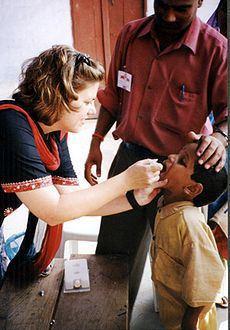Last year, I put myself into some pretty hot water when I wrote a post for Christianity Today’s her.meneutics blog called “Love Your Neighbor. Get Your Vaccines.” Well, ‘hot water’ in the sense that I had angry folks stalking me around the Internet to say mean things to me. At the time I wrote the piece, I assumed that most children who were unvaccinated (or under-vaccinated) were so because their parents had philosophical objections or believed–against plenty of solid scientific evidence to the contrary–that vaccines were harmful.

Child receives oral polio vaccine. (Via Wikipedia; used under CC license.)
I remember talking to a fellow Presbyterian Church (USA) employee, who’s a medical doctor, about the online kerfuffle, and she brought up something I’d never considered: that sometimes people are un- or under-vaccinated not for these reasons but because of the relative (to other developed countries) inaccessibility and high expense of vaccination generally. This week, Mother Jones has an interesting article showing how true that probably is. It’s called “The Real Reason Kids Aren’t Getting Vaccinated” and is brief enough to read in full. But here is one of the most interesting bits, citing a very illuminating study:
“The study found that an astonishing 49 percent of toddlers born from 2004 through 2008 hadn’t had all their shots by their second birthday, but only about 2 percent had parents who refused to have them vaccinated. They were missing shots for pretty mundane reasons—parents’ work schedules, transportation problems, insurance hiccups. An earlier CDC study concluded that children in poor communities were more likely to miss their shots than those in wealthier neighborhoods, and while that may not be too surprising, it’s still a dangerous pattern. “If you’re going to delay one or two vaccines, it’s not going to make a huge difference,” says the new study’s lead author, Jason Glanz, an epidemiologist at the Kaiser Permanente Colorado Institute for Health Research. “But you could also think of it like this: If a million kids delay their vaccines by a month, that’s time during which a disease could spread.”
That’s no mere hypothetical. In 1990, for example, an outbreak of measles killed 89 kids in the United States—most of them from poor families who said they couldn’t afford the vaccine. A 2008 outbreak in San Diego resulted in 12 cases, this time among kids whose parents had refused the vaccine—but authorities had to quarantine an additional 48 who were too young to be vaccinated. The episode cost taxpayers an estimated $10,376 per case.”
and
“To be sure, access to vaccines has been improving nationwide. The federal government now offers free shots to children who aren’t otherwise covered. But the program doesn’t cover adult vaccines, most of which cost from $20 to $100, even for diseases that are easily passed from adults to kids, like whooping cough—which can kill infants.”
(People who are going to be around babies, including folks like postpartum doulas and, well, expectant parents, are now often counseled, I think wisely, to get pertussis boosters.)
It’s just another example of what the stakes in health care reform really are. And since I see people whose bodies have been disabled and deformed by polio nearly every time I go out, those stakes seem even higher.
